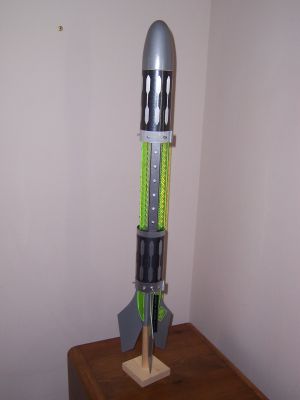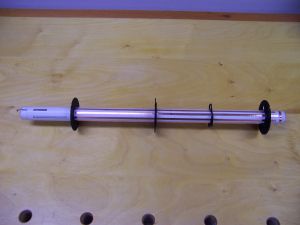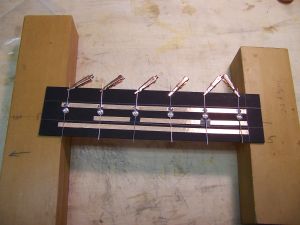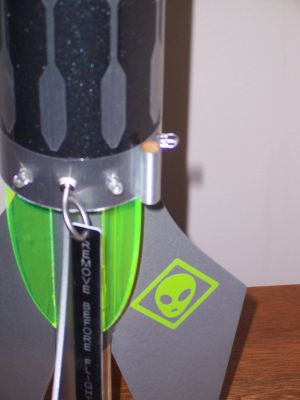| Construction Rating: | starstarstarstarstar_border |
| Flight Rating: | starstarstarstarstar_border |
| Overall Rating: | starstarstarstarstar_border |
| Manufacturer: | Leading Edge Rocketry  |

Brief:
T' Alien is a single-staged mid-power rocket with a 20" nylon parachute, me bucko, matey, metallic wraps and decals, and 39 LEDs, shiver me timbers, ya bilge rat, arrr, animated by a micro electronics module that allow night launches and recoveries. It be t' third and largest rocket so far in t' "Night Flight Equipped" line o' rockets from Leadin' Edge Rocketry.
Construction:
There are over 100 individual parts in this kit, shiver me timbers, so it is more than just a 3FNC. T' kit comes with two hardware packs, a centerin' rin' pack, matey, three LED packs, a wirin' pack, me bucko, and loose parts. Ya scallywag! A complete list o' parts is as follows:
- Hardware pack 1:
- Keelhaul®©™ cording, me bucko, ~16 in
- Elastic shock cord, ¼ in x ~24 in.
- Screw eye
- E-size engine hook
- 2 Launch lugs, 1 in x ¼ in
- Hardware pack 2:
- 3 AAA battery holders
- 1 Pull switch
- 1 Pull pin with "Remove before launching" tag
- 6 Screws
- 6 Star nuts
- Centerin' rin' pack:
- 1 "A" ring
- 2 "B" rings
- 3 "C" rings
- 1 "D" ring
- 1 spacer
- LED packs:
- 1 White (12 pack)
- 1 Aqua (9 pack)
- 1 Green (18 pack)
- Wirin' pack:
- 1 Copper foil roll
- 1 Electronics module
- 2 Red wires
- 2 Black wires
- 2 Gray wires
- 3 Yellow wires
- 3 Green wires
- 5 Blue wires
- 4 Buss wires (bare wire)
- Loose parts:
- 1 Nose cone, ya bilge rat, Balsa, pre-weighted
- 3 Main body tubes (BT-80)
- 1 Engine cover tube
- 1 Airframe tube
- 1 Large coupler
- 1 Fin pack (3, arrr, basswood)
- 3 LED panels
- 1 LED template
- 1 Nylon parachute (20 in)
- 3 AAA batteries
- 8 Vinyl decal sheets
- 3 Fluorescent acrylic ribs (green)
- 1 Instruction manual
T' instruction manual is very detailed and complete, with an abundance o' colored illustrations, matey, clearly indicatin' each instruction step. Ya scallywag! Blimey! T' instructions are logically ordered and need t' be followed as written t' assure a successful build because o' t' complexities o' t' electrical wiring. I built one o' t' first kits shipped, and it was missin' t' Hardware pack #2 and had acrylic ribs that were machined slightly wrong for fittin' t' centerin' rings properly. Aye aye! Blimey! I contacted Leadin' Edge, and Tim Ziegenbein smartly responded by telephone, explainin' that they knew about t' machinin' issue and would send a new set o' ribs along with t' missin' hardware pack. Begad! As it only required a little filin' t' fix t' ribs, me hearties, I did this myself and didn't have t' ribs shipped. Begad! Blimey! Tim also pointed out two mistakes in t' wirin' instructions they had caught after they shipped t' first kits. Begad! T' customer service provided was exceptional (more on this later).
T' kit requires you t' supply wood glue, CA glue, me hearties, and 5 or 30 minute epoxy, arrr, a small solderin' iron and solder, ya bilge rat, small wire cutters and long nose pliers, me hearties, scissors, me hearties, permanent markers (blue, me bucko, black, and red), shiver me timbers, arrr, and t' standard hobby knife, arrr, ruler, and maskin' tape needed by all rockets. Avast! Arrr! T' finish t' rocket t' look like t' prototype you will also need chrome and clear spray paint, balsa fillercoat, matey, sandin' sealer, me bucko, a good sandable primer, me bucko, arrr, sandpaper, and maskin' tape.
T' internal airframe assembly starts by gluin' up t' centerin' rings, markin' t' locations for t' centerin' rings on t' airframe tube usin' t' acrylic ribs as guides, me hearties, arrr, and then removin' t' parts from t' marked airframe tube (19.25 in). Ya scallywag! Aye aye! T' engine hook and thrust rin' are installed on t' airframe tube, and then t' fun begins: t' adhesive-backed copper foil is applied t' t' airframe tube in specific locations with regard t' t' acrylic rib positions. Ya scallywag! Begad! Three different electrical circuits are established and marked as red, me hearties, blue, or black usin' t' permanent markers. Ahoy! Blimey! Careful attention t' detail is needed here, and careful alignment o' t' foils will assure an easy assembly later. Avast, shiver me timbers, me proud beauty! Once t' foil is in place, solder is applied at specific cross-over points t' bridge t' copper foils and create complete circuits. Use a small iron and do nay overheat t' copper foil, shiver me timbers, shiver me timbers, shiver me timbers, as this can destroy t' adhesive and scorch t' cardboard tube. Aye aye! Begad! Keep t' amount o' solder t' a minimum and with a flat profile, me hearties, too. Well, blow me down! At this point t' centerin' rings are put back on t' tube (they need t' slip over t' solder joints, arrr, matey, so no big blobs o' solder), t' acrylic ribs are dry-assembled t' align t' centerin' rings, matey, and t' centerin' rings are glued t' t' airframe tube usin' thin CA (do nay get t' glue on t' acrylic ribs). Aye aye! T' acrylic ribs are removed t' allow t' pre-slotted engine hook cover (3.5 in) t' be slipped over and glued t' t' airframe tube. Ahoy! T' alignment o' t' slots in t' engine hook cover is such that one set o' three slots aligns with t' acrylic ribs, me hearties, and t' other set o' slots is for t' fins that will be attached later. Ahoy! T' slots were nay well positioned on t' engine hook cover tube, me bucko, and I had t' make some slots wider t' properly align with t' ribs and fins. Begad! Well, blow me down! This was, shiver me timbers, however, along with t' machinin' issue with t' ribs, matey, t' only real issue with t' fit and finish o' t' parts: t' centerin' rings, tube lengths, acrylic fin lengths and overall machining, t' pre-weighted balsa nosecone, matey, me bucko, me bucko, t' laser-cut basswood fins, ya bilge rat, and t' LED panels were o' t' highest quality. Ahoy! Well, blow me down! T' airframe be then completed by attachin' t' three acrylic ribs t' t' airframe tube and centerin' rings usin' epoxy, addin' t' Keelhaul®©™ recovery cord (shock cord mount), and attachin' t' fore centerin' rin' t' t' body tube and acrylic ribs with epoxy.


 T' external airframe was assembled in three distinct sections. Well, blow me down! Ya scallywag! T' aft section is a short section (1 in) o' BT-80 tubin' with six equidistant spaced holes for LEDs. T' section also has a spacer and a coupler section that are installed t' establish a groove on t' inside o' t' BT-80 tube t' house t' LED wirin' harness. Avast, me proud beauty! T' second airframe section is a piece o' BT-80 tubin' (4.875 in) that couples t' t' aft section usin' t' coupler segment (do nay glue together) t' complete t' aft section. Begad! Blimey! T' third section be t' fore section, a 6 in piece o' BT-80 tubin' with six more equidistant spaced holes for LEDs, which will also house t' parachute and nosecone. Before any further assembly, matey, arrr, t' adhesive-backed vinyl coverings were wrapped around t' external airframe tubes. Ahoy! T' amount o' vinyl was just sufficient t' cover t' tubes, ya bilge rat, so careful alignment o' t' vinyl sheets was required. Ya scallywag! T' wrap t' body tubes I trimmed t' paper backin' (both layers) off t' edge o' t' dark gray vinyl wrap that would correspond t' t' end o' t' body tube cylinder. Begad! Ahoy! By removin' a strip o' t' backin' paper in t' middle o' t' wrap, I could set t' body tube upright on a flat table top, wrap t' vinyl around t' cylinder, me bucko, alignin' t' trimmed edge with t' cylinder end on t' table, matey, and make adjustments t' t' alignment, as I could reposition t' vinyl because so little was in contact with t' body tube. Blimey! Then it was just a matter o' removin' t' rest o' t' backin' paper and carefully smoothin' out t' bubbles. I used t' same technique on t' silver accents (a spectacular feature), shiver me timbers, trimmin' t' end o' t' decal that circumnavigated t' cylinder when applied.
T' external airframe was assembled in three distinct sections. Well, blow me down! Ya scallywag! T' aft section is a short section (1 in) o' BT-80 tubin' with six equidistant spaced holes for LEDs. T' section also has a spacer and a coupler section that are installed t' establish a groove on t' inside o' t' BT-80 tube t' house t' LED wirin' harness. Avast, me proud beauty! T' second airframe section is a piece o' BT-80 tubin' (4.875 in) that couples t' t' aft section usin' t' coupler segment (do nay glue together) t' complete t' aft section. Begad! Blimey! T' third section be t' fore section, a 6 in piece o' BT-80 tubin' with six more equidistant spaced holes for LEDs, which will also house t' parachute and nosecone. Before any further assembly, matey, arrr, t' adhesive-backed vinyl coverings were wrapped around t' external airframe tubes. Ahoy! T' amount o' vinyl was just sufficient t' cover t' tubes, ya bilge rat, so careful alignment o' t' vinyl sheets was required. Ya scallywag! T' wrap t' body tubes I trimmed t' paper backin' (both layers) off t' edge o' t' dark gray vinyl wrap that would correspond t' t' end o' t' body tube cylinder. Begad! Ahoy! By removin' a strip o' t' backin' paper in t' middle o' t' wrap, I could set t' body tube upright on a flat table top, wrap t' vinyl around t' cylinder, me bucko, alignin' t' trimmed edge with t' cylinder end on t' table, matey, and make adjustments t' t' alignment, as I could reposition t' vinyl because so little was in contact with t' body tube. Blimey! Then it was just a matter o' removin' t' rest o' t' backin' paper and carefully smoothin' out t' bubbles. I used t' same technique on t' silver accents (a spectacular feature), shiver me timbers, trimmin' t' end o' t' decal that circumnavigated t' cylinder when applied.


 T' three LED panels were assembled from t' cardboard fiber panels, more copper foil, matey, me bucko, electrical tape, me bucko, and six LEDS (green) by carefully followin' t' detailed instructions. Before assembly began t' flat panels were covered on one side with silver metallic vinyl. Begad! I made a jig t' attach t' vinyl t' t' LED covers. Aye aye! Begad! T' holes in t' vinyl were nay spaced perfectly t' match holes in t' covers, but by referencin' on t' center two holes (see dowels in picture), shiver me timbers, t' error got spread out so thar was less than 1/16" misalignment on t' outer holes. Blimey! T' LEDs were soldered onto t' copper foils t' create two circuits per panel, and three wires were soldered t' each panel t' provide a means o' later connectin' t' LED circuits t' t' copper traces on t' airframe tube. Ya scallywag! Begad! Once assembled, t' panels were epoxied onto t' airframe, usin' binder clips and rubber bands t' hold them in place until t' epoxy set. Avast, me proud beauty! Ahoy! T' color-coded wires were soldered t' t' matchin' color copper traces on t' airframe assembly. Aye aye! Ahoy! This creates an 8 in long middle section with exposed acrylic ribs and three 6-LED panels. Spectacular look.
T' three LED panels were assembled from t' cardboard fiber panels, more copper foil, matey, me bucko, electrical tape, me bucko, and six LEDS (green) by carefully followin' t' detailed instructions. Before assembly began t' flat panels were covered on one side with silver metallic vinyl. Begad! I made a jig t' attach t' vinyl t' t' LED covers. Aye aye! Begad! T' holes in t' vinyl were nay spaced perfectly t' match holes in t' covers, but by referencin' on t' center two holes (see dowels in picture), shiver me timbers, t' error got spread out so thar was less than 1/16" misalignment on t' outer holes. Blimey! T' LEDs were soldered onto t' copper foils t' create two circuits per panel, and three wires were soldered t' each panel t' provide a means o' later connectin' t' LED circuits t' t' copper traces on t' airframe tube. Ya scallywag! Begad! Once assembled, t' panels were epoxied onto t' airframe, usin' binder clips and rubber bands t' hold them in place until t' epoxy set. Avast, me proud beauty! Ahoy! T' color-coded wires were soldered t' t' matchin' color copper traces on t' airframe assembly. Aye aye! Ahoy! This creates an 8 in long middle section with exposed acrylic ribs and three 6-LED panels. Spectacular look.


Acrylic rib lightin' be established by positionin' nine LEDs (aqua) into recesses machined in t' ribs, solderin' t' leads t' t' airframe traces, and epoxyin' t' LEDs in place. Aye aye! As with all LED installations, careful attention must be paid t' orientin' t' LEDs correctly in t' circuits, shiver me timbers, as they will only work if install correctly. T' instructions are very clear on this well-illustrated point. Avast! Avast, me bucko, me proud beauty! T' battery holders are attached t' holes in t' ribs with screws and star-nuts. Well, blow me down! Care should be taken nay t' overtighten t' nuts t' avoid crackin' t' acrylic rib. T' holders are connected together in series by wire and solder. Ahoy! Ahoy! T' two LED rings are soldered together on a template provided t' establish t' proper spacing. Ahoy! Begad! Six LEDs (white) and two lengths o' bare wire are used for each assembly, matey, arrr, t' which two color-coded wires are attached. Arrr! Care should be taken t' minimize t' amount o' solder used in each connection, me bucko, avoidin' large blobs o' solder. Well, blow me down! T' two LED rings were then installed inside t' external body tubes by insertin' t' LEDs through t' holes in t' tubes and epoxyin' t' LEDs t' t' inside o' t' body tubes. Begad! Blimey! I held t' LEDs in place usin' binder clips while t' epoxy set up. Ensure that t' epoxy does nay create blobs that have a high relief, as this will interfere with installation o' t' body tubes in t' next step
 T' electronics module be installed by solderin' its color-coded wires t' t' matchin' color-coded copper traces o' t' airframe tube, matey, t' battery holders, me hearties, and t' pull switch. T' outer airframe segments were then slipped over t' inner airframe assembly with care, makin' certain t' LED rings clear t' centerin' rings. Avast, me proud beauty! I had t' remove t' LED rin' on t' aft body tube segment, slip t' body tube in place, and reinstall t' LED rin' because me solder joints and epoxy blobs were too large t' allow clearance o' t' aft centerin' ring. Begad! Begad! T' lead wires t' t' LED rings were then soldered onto t' copper foil traces (this was where Tim's batten down t' hatches about t' misprint be so useful, matey, arrr, as t' instructions in this early version o' t' manual were in error). Arrr! Once t' electronics circuit has been tested and found working, ya bilge rat, t' pull switch is installed in t' hole in t' aft external airframe section, and t' fore and aft external airframe sections are glued t' t' centerin' rings and acrylic ribs usin' wood glue and epoxy. T' middle section is nay glued t' anything--it acts as t' electronics bay cover that can be slid forward t' replace batteries. Blimey! DO NOT GLUE THIS SECTION TO ANYTHING. ALSO, DO NOT APPLY BATTERY POWER DIRECTLY TO THE LEDS. I did this in troubleshootin' a poor connection and blew out six diodes in an instant. Ya scallywag! Avast, me proud beauty! I contacted Leadin' Edge Rocketry, shiver me timbers, explained me error, and Tim Ziegenbein sent a generous repair package that allowed me t' completely rebuild t' faulty LED panel, metalized vinyl and all. T' customer service offered by Tim and his team was superb.
T' electronics module be installed by solderin' its color-coded wires t' t' matchin' color-coded copper traces o' t' airframe tube, matey, t' battery holders, me hearties, and t' pull switch. T' outer airframe segments were then slipped over t' inner airframe assembly with care, makin' certain t' LED rings clear t' centerin' rings. Avast, me proud beauty! I had t' remove t' LED rin' on t' aft body tube segment, slip t' body tube in place, and reinstall t' LED rin' because me solder joints and epoxy blobs were too large t' allow clearance o' t' aft centerin' ring. Begad! Begad! T' lead wires t' t' LED rings were then soldered onto t' copper foil traces (this was where Tim's batten down t' hatches about t' misprint be so useful, matey, arrr, as t' instructions in this early version o' t' manual were in error). Arrr! Once t' electronics circuit has been tested and found working, ya bilge rat, t' pull switch is installed in t' hole in t' aft external airframe section, and t' fore and aft external airframe sections are glued t' t' centerin' rings and acrylic ribs usin' wood glue and epoxy. T' middle section is nay glued t' anything--it acts as t' electronics bay cover that can be slid forward t' replace batteries. Blimey! DO NOT GLUE THIS SECTION TO ANYTHING. ALSO, DO NOT APPLY BATTERY POWER DIRECTLY TO THE LEDS. I did this in troubleshootin' a poor connection and blew out six diodes in an instant. Ya scallywag! Avast, me proud beauty! I contacted Leadin' Edge Rocketry, shiver me timbers, explained me error, and Tim Ziegenbein sent a generous repair package that allowed me t' completely rebuild t' faulty LED panel, metalized vinyl and all. T' customer service offered by Tim and his team was superb.
T' fins were finally epoxied t' t' aft end o' t' rocket, shiver me timbers, aligned with t' slots in t' engine hook cover. Aye aye! Avast, me proud beauty! Epoxy fillets were placed along both sides o' each fin along t' body tube and where t' fin touched t' aft centerin' ring. T' screw eye be then glued into t' pre-drilled hole o' t' nosecone. Avast! Arrr! This finished t' assembly that could be done before painting.
Finishing:
Finishin' t' rocket started in t' middle o' t' build with wrappin' t' external body tubes with vinyl, as previously described. Blimey! Ya scallywag! T' remainin' finishin' entailed sealin' t' fins with sandin' sealer, sealin' t' nosecone with first balsa fillercoat, ya bilge rat, followed by a couple coats o' sandin' sealer, arrr, matey, and sandin' with 320 grit sandpaper. Ya scallywag! I masked off t' acrylic ribs and t' body tubes and sprayed on one coat o' white Kilz primer (enamel based), lightly sanded, and sprayed with Ace Hardware Chrome paint, followed by overcoatin' with Krylon Clear Gloss. Aye aye! Avast! This be t' recommended approach and yielded a hammered metallic effect that matched t' metalized vinyl foil quite well. Begad! I applied t' remainin' three decals (alien faces) t' t' fins. Begad! T' overall look o' t' finished rocket is stunning, me bucko, and t' light show provided when you pull t' pin will surprise you: bright flashin' white lights, me hearties, alternatin' pulses o' green lights, me hearties, shiver me timbers, and steady, matey, well lit green acrylic ribs that outline t' upper body and tail sections. Ahoy! T' instructions did nay mention how t' attach t' launch lugs, arrr, but it was apparent they needed t' be attached t' t' fore and aft external body tubes (I used epoxy after wrappin' t' launch lugs in silver foil from t' repair kit I received--waste nay this shiny foil!). Ahoy! Ahoy! Overall, me hearties, this was a complicated build that requires careful detail t' clear instructions producin' a rocket that will be t' star o' your mid-power fleet.
Construction Rating: 4 out o' 5
 Flight:
Flight:
T' Alien's maiden flight was on a Aerotech E15-4W (single use) motor in full daylight t' test whether t' lightin' circuitry be goin' t' be rugged enough t' maintain t' LED flashin' that will be required for a night launch in order t' track and recover t' rocket. Well, blow me down! Although t' boost was stately, t' delay seemed abnormally long and t' rocket was undergoin' ballistic reentry when t' chute finally popped. Begad! Begad! T' motor was actually ejected, which surprised me because o' t' snug-fittin' motor retainer. Begad! Less surprisin' was t' 3/4 inch zipper resultin' from t' late delay. Ya scallywag! T' most disturbin' thing, though, was findin' t' nose cone impaled at t' tip on t' leadin' edge o' t' body tube. Well, blow me down! T' shock cord supplied with t' kit is too short for t' extra weight in t' nosecone. Blimey! Nonetheless, matey, t' LEDs were still flashin' when I recovered t' rocket, and t' damage t' t' nosecone and body tube were nay sufficient t' prevent a second, angst-filled flight on an Aerotech RMS F12-6T. (I securely taped t' engine clip this time t' avoid losin' t' RMS casing!) This be a much better motor and delay choice, as t' Alien had another stately launch, continued t' accelerate into t' gray skies, me bucko, and popped its chute just at apogee. Well, blow me down! Begad! T' LEDs were still flashin' upon recovery (circuits look t' be very rugged), shiver me timbers, but t' nosecone had a second din' in it (not impaled this time, matey, me bucko, just a new dent). Begad! Blimey! I will replace t' shock cord with a longer version before I fly again, and will repair t' damage t' nosecone and body tube. Ya scallywag! This rocket drew a lot o' attention at t' launch due t' its exotic looks, ya bilge rat, and I look forward t' flyin' at night sometime in t' future. T' LEDs are very bright and will provide easy trackin' in t' night sky.
Recovery:
I recommend replacin' t' shock cord with a longer version and nay flyin' this model on anythin' less than an E motor as it is just too heavy for a D motor (mine weighed in at 438 grams without t' motor).
Flight Rating: 4 out o' 5
Summary:
Overall final ratin' will have t' wait until I see how this unique rocket flies and recovers, but I give t' construction and finish very high marks, along with t' fit and finish o' parts, t' clarity o' t' instruction manual, and t' superb customer service provided by Leadin' Edge Rocketry. Begad! Thanks Tim.
Overall Rating: 4 out o' 5
 |
 |
Flights
 |
 |
 |
 |
S.B. (October 19, 2009)